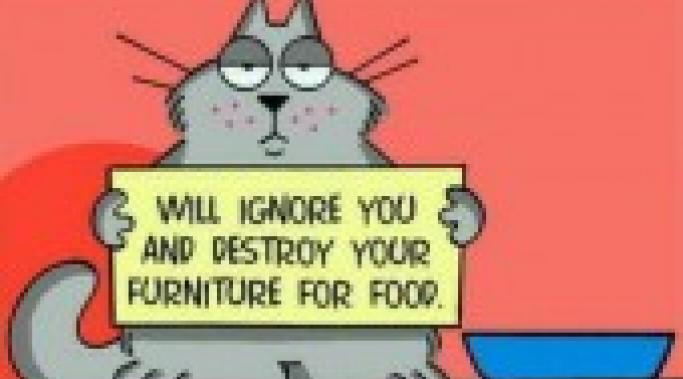The Internet is a repository for mental illnesses of every description, but did you know that the Internet is also one of the leading causes of mental illness? That’s the conclusion of researchers at The Institute for Advanced Study of Studied Institutionalization (IASSI) who recently published a comprehensive white paper detailing their findings.
At a recent press briefing, IASSI spokesman Reginald Frampton elaborated. “Mentally Ill People, referred to as MIPs in our document, are particularly susceptible to the sustained level of psychosis that characterizes Internet traffic.
“MIPs are already having difficulty sorting out what’s real from what’s not, and extended immersion in the stew of dementia found in Facebook and other so called 'social networking' sites – which we at the institute call ‘nutworking’ sites – exacerbates an already worrisome situation.
“Unlike most think tank studies, which are roughly as deep as a Frisbee or the typical TED Talk, we have provided 5 action steps which, if aggressively implemented, will make the Internet safer for MIPs, and a whole lot less tiresome and irritating for non-MIPs. Here they are.
Culture
Those with an interest in the history of American medicine will recall how the delivery infrastructure has evolved through the years, from careless care to poorly managed care to mismanaged care to the paradigm currently in vogue, managed care.
Seems simple enough, and yet, there are as many definitions for managed care as there are for quincunx, so let’s cut through the clutter and have a look at what it actually means, especially in a mental illness/mental health context.
Historically, care could only be denied on a case-by-case basis, which was very time consuming for care providers. Insurance companies struggled with tremendous overhead because it was necessary for them to maintain large departments staffed by professionals skilled at denying claims one at a time.
According to a study released recently by the American Association of Associated Americans (AAAA), insanity may soon be out of reach for all but the super-rich, if current trends continue.
Chumley Throckmorton, PR Liaison for AAAA, explained the findings at a recent press event. “America was founded on democratic values,” he began, “our constitution guarantees specific freedoms like speech, religion, and the pursuit of happiness. Happiness means different things to different people but one thing is certain, for many of us it means embracing our inner whackadoomian and smiling shamelessly as the cheese drifts slowly off the cracker.
“If one quality has helped to shape this nation more than any other it is the enthusiastic celebration of personal insanity,” he smiled. “Madness was no mere colorful side road of the American experience, oh no, looneytude carved Main Street out of a hostile wilderness, tied the sky with wire, clogged the air with carbon monoxide and made the racing rivers glisten with mercury. Toxic levels of greed, ambition, and aggression drove a long parade of pathologically disturbed explorers, industrialists, bankers, bookies, assassins and interior decorators to ravage a utopia of incalculable natural wealth and beauty.
Some of you may remember when “Bring Your Daughter To Work Day” was rolled out. This innocuous exercise in low-grade social engineering was intended to introduce young girls to the entire spectrum of work in order to free them from the socially imposed blinders which psychologically limited their career options to a gruesome choice between homemaker, secretary and waitress.
Apparently it worked. Today there are more women in the workforce than men, and, not unspurprisingly, one might travel many a kilometer of rough gravel today before encountering a homemaker, secretary, or waitress.
So, let’s take heart as we consider that those who strategize and implement our social evolution, them, the powers that be, the hands behind the curtain, those unnamed unknown unseen Machiavellian magicians do in fact know what they are doing because they have our best interests at heart or so I keep telling myself.
In a culture as deeply superficial as ours it is often difficult to tell the authentic from the false.
It is easy to sympathize with the phonies, poseurs, affected wannabe’s and disingenuous empty vessels passing off pilfered ideas as original, skating past any serious analysis or criticism by others as an ant might slide across a non-stick sauce pan slathered with extra virgin olive oil.
Their dilemma is not unfamiliar. How does one stand out in an atmosphere of mass homogenization where, thanks to the constant recycling of mediocre ideas discarded by others, we are reduced to virtual clones, unable to generate anything original or even recognize originality in others?
According to a recent study conducted by the ASAAS (American Society for the Advancement of American Societies), over 93% of U.S. citizens will be touched by mental illness at some point in their lives. With the 2012 census weighing in at a portly 312,780,968, that works out to really a lot of people.
A more detailed breakdown of this massive demographic is very instructive, especially in light of challenges encountered by the mentally ill when seeking employment. The following terms, sanctioned by ASAAS, indicate psychological impairment on an ascending scale of severity (least to worst).
11% - personality enhanced
7% - characters in search of a playwright
9% - strange arrangers
13% - alternate reality ramblers
8% - attending a séance with Syngen
15% - antediluvian starfish
7% - sea lion impersonators
20% - puzzled jig saw chipped tooth sharpeners
3% - bananapram umbrellastand chiming lunar tox
It’s been well over 20 years since I last watched the Oscars and I must confess that not watching them this year was particularly enjoyable. My slow ascent out of the damp crypt known as mental illness has instilled a palpable fear of association with the certifiably insane; I know better than most that crazy is contagious.
As a policy I avoid contact with the pathologically angry, the insecure so brittle they might be shattered by a sneer, fear-driven treacherous backstabbers who would sooner eat shattered glass than speak the truth, and reality TV personalities. I avoid them because I don’t want to catch what they have.
Like so many armchair activists and limousine Liberals, I watched the civil rights struggle unfold from the insulated confines of a bourgeois environment which, had it been any whiter, could have passed for Swiss. I never got any closer to Selma, Alabama than I’ve gotten to Salma, Hayek. However, with the naïve posturing and platitudinizing so essential to the clueless “occupy” lifestyle – as essential, indeed, as the mochalottelenyagrande from Starbucks – I cheered from the sidelines with each brave step forward.
Those were heady, idealistic days when many of us actually did believe that America was going to catch up with its constitution and, as Dr. King phrased it with characteristic elegance, make good on a check it had written nearly two centuries before. Soon we would find out that forward progress in the world of spiritual and moral evolution moves at a glacial pace, if at all, like a circus elephant being pushed up sagging planks into a boxcar by a roustabout unable to recall what first attracted him to show business. But there were pivotal movements.
Americans have a provincial view of the world revolving around exploitation; that is to say, other countries exist only to the extent that we consider them useful. Johnny and Ginny Lunchbucket think of China as the place that produces freighter loads of shabby merchandise we consume, India as the place to call if something breaks, the Middle East as a gas station with uppity attendants, Europe as the place with painting, sculpture, and whatnot, and South America (including central America) as our source for drugs and black market plastic surgery.
Johnny & Ginny Lunchbucket consider Canada the go-to place for criminals fleeing justice, while Australia, which was founded by convicts, is roughly equivalent to Cuba in terms of inability to hold interest. Africa, the very wellspring of humanity itself, has failed to capture the imagination of Mr. and Mrs. Lunchbucket at all – to them it is somewhere in-between an outsized petting zoo and a sweet background for Land Rover commercials.
I am happy to be associated with the Stand Up For Mental Health campaign that HealthyPlace has launched; and I am very proud of all those brave individuals who have helped stamp out stigma by going public with the details of their mental health challenges.









